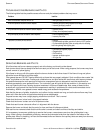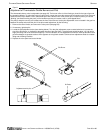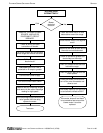
SERVICE PLATINUM SERIES SECTIONAL RANGE
PAGE 34 OF 80 INSTALL & OPERATIONS MANUAL 1185836 REV 3 (07/06)
TROUBLESHOOTING BURNERS AND PILOTS
The following table lists the possible causes of burner and pilot related problems that may occur.
Problem Look for -
None of the burners and pilots will turn on – Main gas supply to unit is OFF.
All burners produce excessive carbon deposits
– Incorrect gas type is being supplied to the range.
– Incorrect gas supply pressure.
Only some burners produce excessive carbon deposits
– Incorrect orifices.
– Primary air not adjusted properly.
Only some pilots produce excessive carbon deposits – Pilot not adjusted properly.
– Incorrect pilot orifice.
Top burner (not oven) will not come on – Pilot out.
– For thermostatic griddles, gas shut off valve is in OFF position.
– For thermostatic griddles, button on safety switch is not being
held in long enough after lighting pilot.
Top section pilot will not remain lit – Pilot flame not adjusted properly.
– Clogged orifice.
– Draft condition.
– Improper ventilation system.
– Air in gas line.
SERVICING BURNERS AND PILOTS
All orifice sizes and burner rates are properly set at the factory and should not be altered.
Each burner should have a steady blue flame on each port of the burner. When using propane, the burners may have
a small amount of yellow tipping.
If the flame is rising up off of the ports adjust the burner shutter to be further closed. If the flame is long and yellow
adjust the burner shutter to be further open.
Over-gassed burners DO NOT heat as efficiently as those that are properly adjusted. Such conditions also create “hot
spots” on griddles and hot tops. Floating and unstable burner and pilot flames will result when solid tops are lowered
into position because the rear openings of the burner compartment are not adequate to vent the enormous flue
products generated by over-gassed burners. The “unburned” gas will ignite at the rear and burn in this section and
even up inside the flue riser, causing structural members in this area to deteriorate. Also, some of these hot flue
products will vent forward into the manifold compartment resulting in problems with valves and thermostats due to
overheating. AGAIN, over-gassed burners waste energy and cause service problems.
Note that the burners of griddle, charbroiler, and uniform hot-top models are long, and so the burner flame may float
when cold. Allow the burner to heat before making burner adjustments.
Propane burners may have a slight popping noise when turned off. This is normal.
Check that the burner is level and in its support brackets.
Check that the burner is clean and all of its ports are clear.
Check that each burner valve and orifice is in alignment with the burner.
Remove the burner and check that its venturi is clean and free of buildup and debris.
With each burner removed check that the orifice size is correct and clean and free of buildup and debris.
If it is necessary to remove a griddle top to service the burners, use extreme care since the griddle plate is very
heavy. When raising a thermostatic griddle top, remove the thermostat bulbs from the tubes on the bottom of the
griddle plate. When re-installing, re-insert the thermostat bulbs and be sure the capillary tubes are away from burners,
flames and excessive heat.


















